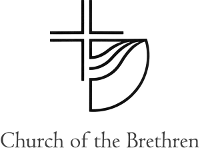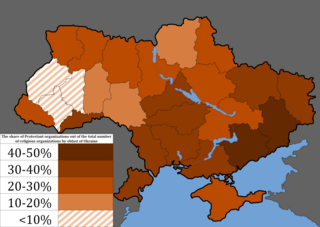Related Research Articles

The Church of the Brethren is an Anabaptist Christian denomination in the Schwarzenau Brethren tradition that was organized in 1708 by Alexander Mack in Schwarzenau, Germany during the Radical Pietist revival. The denomination holds the New Testament as its only creed. Historically, the church has taken a strong stance for nonresistance or Christian pacifism—it is one of the three historic peace churches, alongside the Mennonites and Quakers. Distinctive practices include believer's baptism by forward trine immersion; a threefold love feast consisting of feet washing, a fellowship meal, and communion; anointing for healing; and the holy kiss. Its headquarters are in Elgin, Illinois, United States.

The Missionary Church is an evangelical Christian denomination of Anabaptist origins with Wesleyan and Pietist influences.
The Church of the United Brethren in Christ is an evangelical Christian denomination with churches in 17 countries. It is Protestant, with an episcopal structure and Arminian theology, with roots in the Mennonite and German Reformed communities of 18th-century Pennsylvania, as well as close ties to Methodism. It was organized in 1800 by Martin Boehm and Philip William Otterbein and is the first American denomination that was not transplanted from Europe. It emerged from United Brethren churches that were at first unorganized, and not all of which joined this church when it was formally organized in 1800, following a 1789 conference at the Otterbein Church.
The Rosedale Network of Churches is a Christian body of Mennonite churches in the Anabaptist tradition. Rosedale Network of Churches was originally formed in 1910 by a group of Amish Mennonites to promote unity while preserving autonomy of the local congregation.

The Mennonite Church USA is an Anabaptist Christian denomination in the United States. Although the organization is a recent 2002 merger of the Mennonite Church and the General Conference Mennonite Church, the body has roots in the Radical Reformation of the 16th century.

Goshen College is a private Mennonite liberal arts college in Goshen, Indiana. It was founded in 1894 as the Elkhart Institute of Science, Industry and the Arts, and is affiliated with Mennonite Church USA. The college is accredited by the Higher Learning Commission and has an enrollment of 749 students. While Goshen maintains a distinctive liberal Mennonite worldview and Mennonites make up 30 percent of the student body, it admits students of all religions.
Amish Mennonites came into existence through reform movements among North American Amish mainly between 1862 and 1878. These Amish moved away from the old Amish traditions and drew near to the Mennonites, becoming Mennonites of Amish origin. Over the decades, most Amish Mennonites groups removed the word "Amish" from the name of their congregations or merged with Mennonite groups.

Anabaptist Mennonite Biblical Seminary (AMBS) is an Anabaptist Christian seminary in Elkhart, Indiana, affiliated with Mennonite Church USA and Mennonite Church Canada. It was formerly known as Associated Mennonite Biblical Seminary until its name was changed in 2012.

The General Conference Mennonite Church (GCMC) was a mainline association of Mennonite congregations based in North America from 1860 to 2002. The conference was formed in 1860 when congregations in Iowa invited North American Mennonites to join together in order to pursue common goals such as higher education and mission work. The conference was especially attractive to recent Mennonite and Amish immigrants to North America and expanded considerably when thousands of Russian Mennonites arrived in North America starting in the 1870s. Conference offices were located in Winnipeg, Manitoba and North Newton, Kansas. The conference supported a seminary and several colleges. In the 1990s the conference had 64,431 members in 410 congregations in Canada, the United States and South America. After decades of cooperation with the Mennonite Church, the two groups reorganized into Mennonite Church Canada in 2000 and Mennonite Church USA in 2002.
Located in Smithville, Ohio, Oak Grove Mennonite Church is an historical church that has made a significant contribution to the larger Mennonite denomination, currently pastored by Doug Zehr. Oak Grove started as an Amish church in 1818, as many Amish started settling in Wayne County, Ohio. From humble beginnings the church grew and built a meetinghouse in 1862, one of the earliest of such meetinghouses the Amish have built.

Rosedale Bible College (RBC) is a private evangelical Anabaptist junior Bible college in Rosedale, Ohio. RBC offers an Associate in Biblical Studies accredited by the Commission on Accreditation of the Association for Biblical Higher Education. The college is owned by the Rosedale Network of Churches, a coalition of roughly 120 widely scattered churches within the Mennonite family of faith, and united by a evangelical-Anabaptist theology.
Biblical Mennonite Alliance (BMA) is an organization of Conservative Mennonite Anabaptist congregations located primarily in the eastern two thirds of the US and Canada, with some international affiliates. The BMA congregations are organized into groups called Regionals that are under the oversight of ordained ministers called Overseers.

Protestants in Ukraine number about 600,000 to 700,000 (2007), about 2% of the total population. Nearly all traditional Protestant denominations are represented in the country. According to Christianity Today magazine, Ukraine has become not just the "Bible Belt" of Eastern Europe, but a "hub of evangelical church life, education, and missions". At present, the country is a key supplier of missionaries and a center of evangelical training and press printing for all the countries of the former Soviet Union, where the legal environment is not so favourable.
The Mennonite Church USA Archives was founded in 2001 under the denominational merger of the (old) Mennonite Church and the General Conference Mennonite Church. Prior to 2001, the two largest Mennonite denominations maintained separate archives: the Archives of the Mennonite Church, located on the Goshen College campus, housed materials pertaining to the (old) Mennonite Church, while the Mennonite Library and Archives on the Bethel College campus held the records of the General Conference Mennonite Church.
Emma Elizabeth Richards was the first Mennonite woman to be ordained as a pastor of a Mennonite congregation.

Olive Mennonite Church is a Mennonite Church located just outside Wakarusa, Indiana, and a member of the Indiana-Michigan Mennonite Conference of Mennonite Church USA.
College Mennonite Church (CMC) is a Mennonite Church located in Goshen, Indiana, and a member of the Indiana-Michigan Mennonite Conference of Mennonite Church USA.

Black Mennonites are people who are both Mennonite and Black. Black Mennonites live in Africa, the United States, Canada, and elsewhere. Black Mennonite communities have existed in the United States and Canada since the late 1800s. Ethiopia and the Democratic Republic of the Congo are home to the second and fourth largest populations of Mennonites in the world. Tanzania, Zimbabwe, Kenya, and Angola also have some of the larger populations of Mennonites in the world. Glen Alexander Guyton, the first African-American leader of the Mennonite Church USA, has stated that "The typical Mennonite is an African woman", due to Mennonite missionary outreach in Africa, and that African Mennonites "are now sending missionaries to Europe and the United States." While Mennonites have historically been mostly white people of Central or Eastern European descent, with population centers in North America and Europe, Black Mennonites now outnumber white Mennonites globally. African Mennonite churches have had a larger number of members than North American Mennonite churches since 2006.
References
- ↑ Wenger, John Christian (1961). The Mennonites in Indiana and Michigan. Scottdale, PA: Mennonite Publishing House.
- 1 2 3 Schlabach, Theron (2003). "History". College Mennonite Church: 1903-2003. ed. Ervin Beck: 17–130.
- ↑ Bender, Harold S. "Goshen College Mennonite Church (Goshen, Indiana, USA)". Global Anabaptist Mennonite Encyclopedia Online. Herald Press. Retrieved 20 February 2012.[ permanent dead link ]
- 1 2 3 4 5 6 Yoder, Mary Lehman. "Assembly Mennonite". Who We Are. Indiana-Michigan Mennonite Conference. Retrieved 5 March 2012.[ permanent dead link ]
- 1 2 3 "A Brief History of Assembly". AssemblyMennonite.org. Mennonite.net. Retrieved 5 March 2012.
- ↑ Burkholder, J. R>. "About the Assembly History Project". AssemblyMennonite.org. Mennonite.net. Archived from the original on 14 April 2013. Retrieved 5 March 2012.